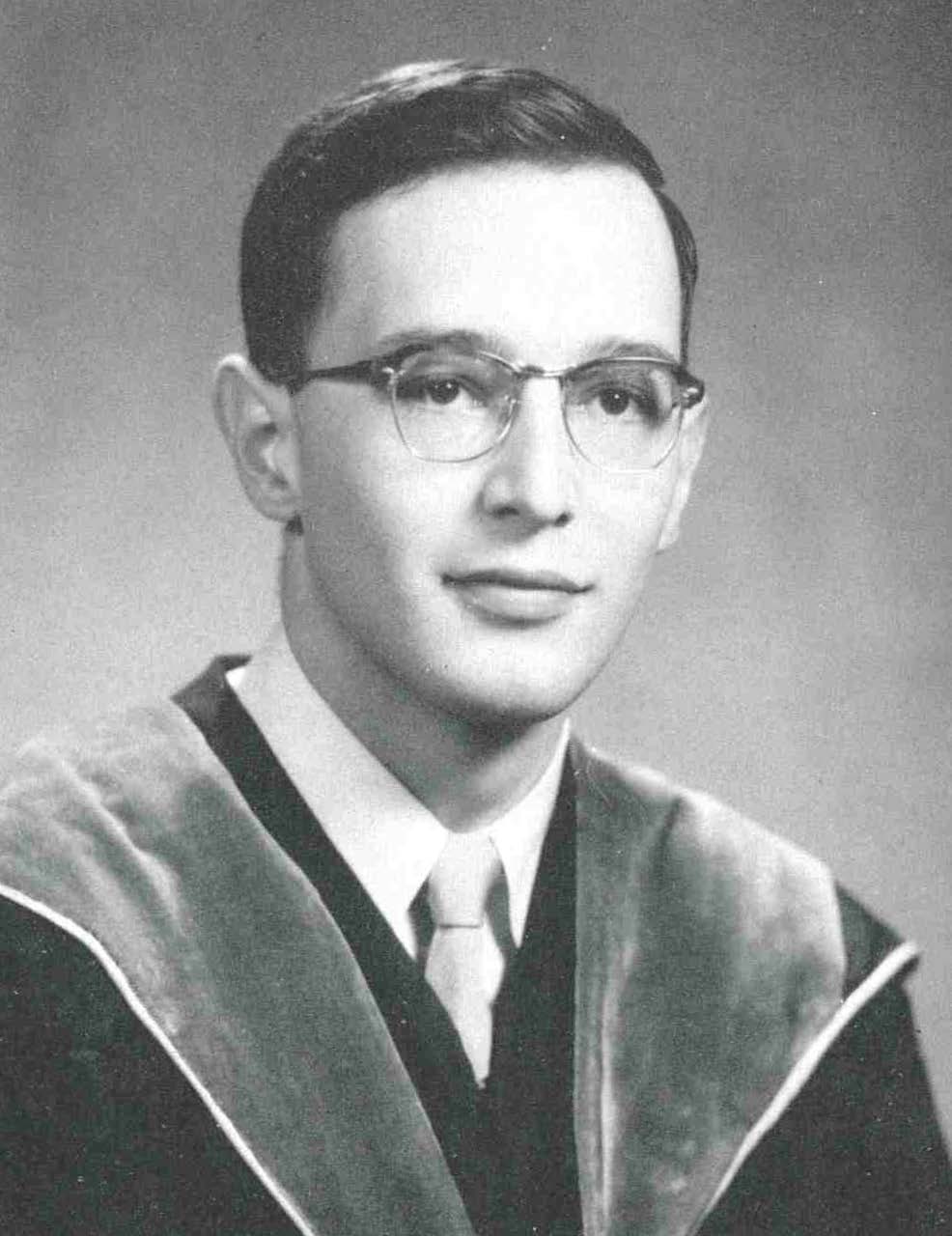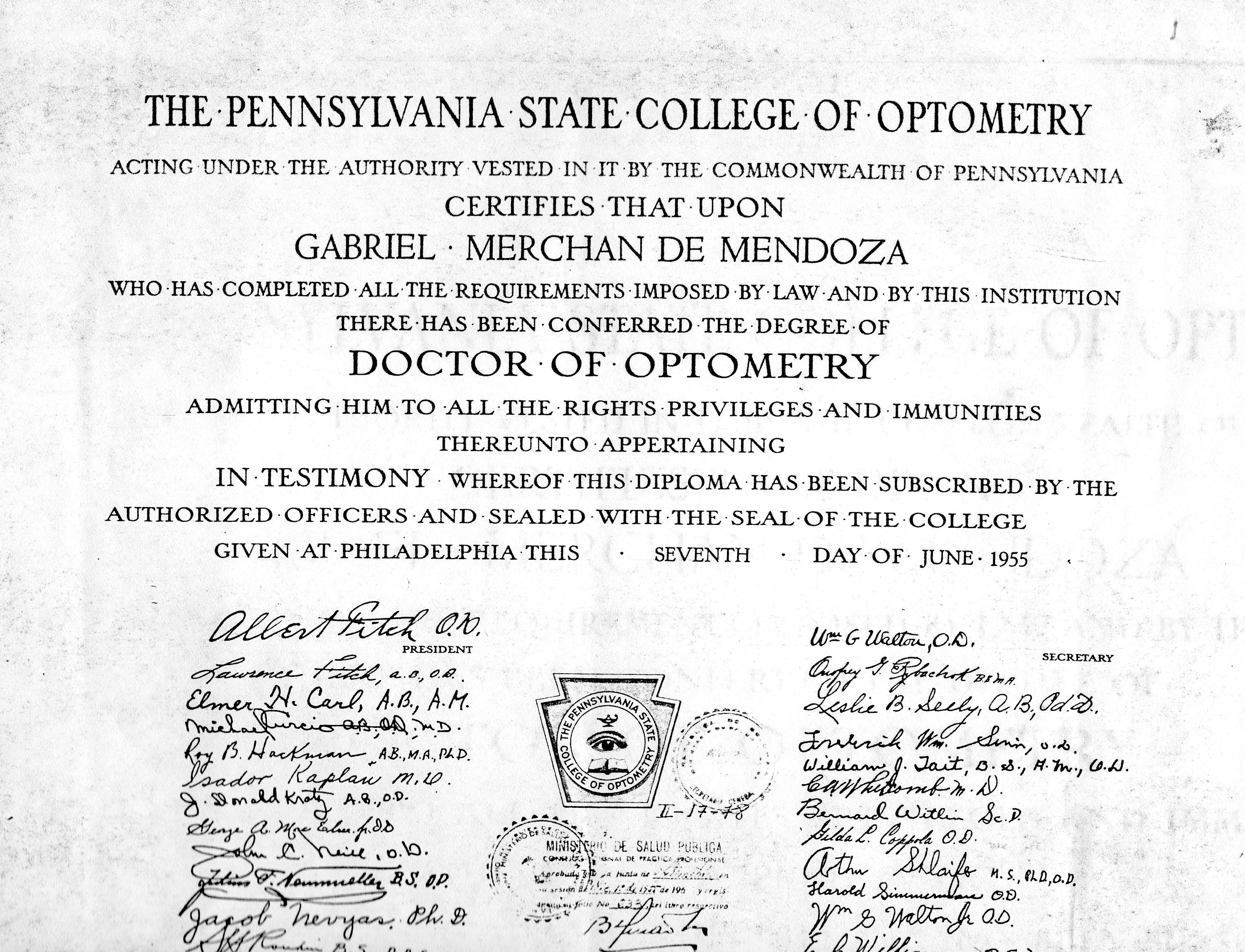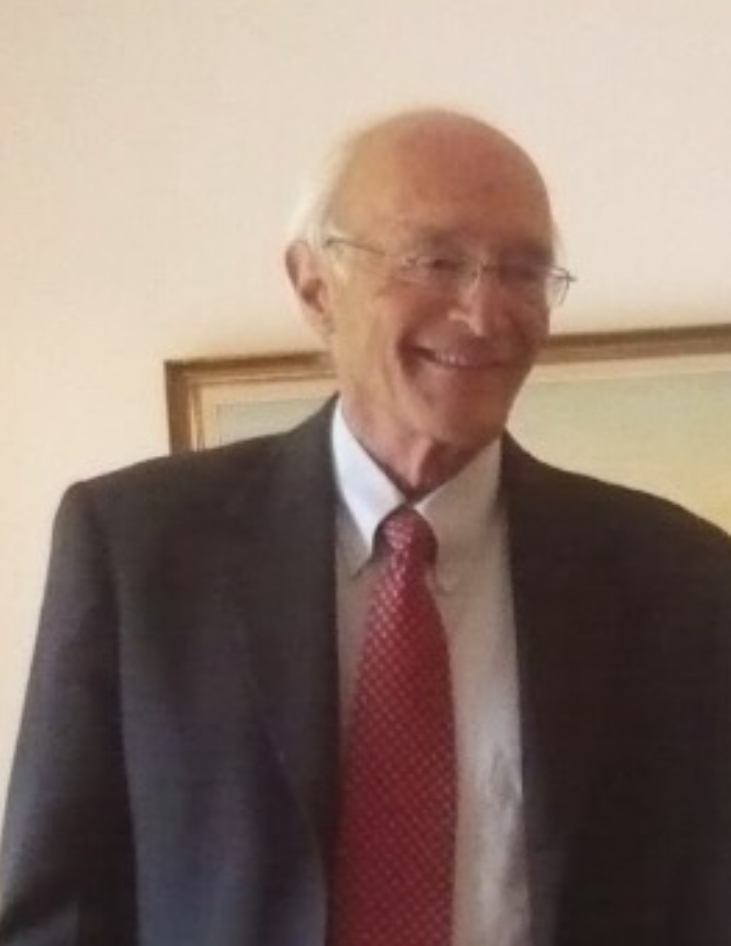The following article was written by Dr. Gabriel Merchán-De Mendoza about his life and career since graduation from the Pennsylvania State College of Optometry (PSCO) in 1955.
Hello everyone, greetings from Colombia to all my Pennsylvania State College of Optometry (PSCO) 1955 classmates and faculty members that may still be around. I would be extremely happy to hear from any of you. My e-mail is gabemerchan@gmail.com.
 Immediately after graduation I attended Bok Vocational School in South Philly to improve my skills on mechanical optics workshop. Then I returned home in Bogotá (Colombia’s capital) to set up my practice. Optometry in Colombia at the time, followed the German Optical Shop style consisting of a fully equipped examining room and a store wherein prescriptions were filled and sold. These are called “Opticas.” Ethics were rigorously enforced to avoid unethical commercial practices.
Immediately after graduation I attended Bok Vocational School in South Philly to improve my skills on mechanical optics workshop. Then I returned home in Bogotá (Colombia’s capital) to set up my practice. Optometry in Colombia at the time, followed the German Optical Shop style consisting of a fully equipped examining room and a store wherein prescriptions were filled and sold. These are called “Opticas.” Ethics were rigorously enforced to avoid unethical commercial practices.
Optometry in Colombia in 1955 was as follows: There were no optometry schools but only a handful of 12 or 15 graduated optometrists in Bogotá, most of them of German origin and some U.S graduates. We had some 700 or so people practicing optometry in an empirical way, “quacks” if you may. The feud with ophthalmology was very much like in the U.S. in the fifties. Optometry was legally recognized since 1933 with current limitations regarding the use of drugs.
I began practice in 1956 in my own “Optica” and three years later got married to Julia for the next 52 years when she passed away. We were blessed with six wonderful children, the oldest, graduated as an optometrist from La Salle University, Bogotá. In 1959 I was invited by Doctor José Ignacio Barraquer, MD, (keratomileusis) to become part of his optometric staff which I enjoyed for the next ten years simultaneously with my private practice.
 By 1966, Universidad De La Salle in Bogotá founded the first South American School of Optometry which I joined six months later as part of the faculty to teach theoretical optometry to second semester students. Eventually, I found myself teaching clinical proceedings, mechanical optics, visual graphic analysis, theoretical optometry, contact lenses, theory and practice, statistics and was the director of the optometric clinic.
By 1966, Universidad De La Salle in Bogotá founded the first South American School of Optometry which I joined six months later as part of the faculty to teach theoretical optometry to second semester students. Eventually, I found myself teaching clinical proceedings, mechanical optics, visual graphic analysis, theoretical optometry, contact lenses, theory and practice, statistics and was the director of the optometric clinic.
In 1975, I was appointed Dean and stayed in that position for the next ten years. Thanks to the support of my staff and Jerald Strickland, OD, PhD, past dean and chief academic officer of the Pennsylvania College of Optometry (PCO) who then worked for the University of Houston (UH), we were able to implement a new academic curriculum closely resembling PCO’s. It was a great success and La Salle School of Optometry became the leading optometric school in all Latin America. Eventually I ascended to the categories of full professor, distinguished professor, professor emeritus and honorary professor.
“I admire Dr. Merchan and his early work with Colombian ophthalmology,” Dr. Strickland said when asked to comment on this piece. “I have the highest regard for Dr. Merchan and I admire him as an optometric leader in the Western hemisphere.”
By the time I assumed the Office of the Dean, the School lacked a clinical facility for the student’s clinical practice and I am very proud to say that the University higher authorities approved my plan for the construction of a five-story building that included 40 examining rooms, library, auditorium, cafeteria, parking garage and offices for the academic and administrative staffs.
In 1985, I left the Office of the Dean to organize post-graduate courses in Pediatric Optometry and Contact Lenses in the modality of specialties. My daughter María Susana is currently a Pediatric Optometrist dedicated mostly to the early evaluation of prematurely born babies.
Simultaneously with my private practice and academic work at La Salle, I became involved in professional affairs as a member of the Federation of Colombian Optometrists, FEDOPTO, which had grown from 12 members in the fifties to a thousand, give or take, in the nineties, thanks to new optometrists coming out of the various new optometry schools that flourished by then.
 As member of FEDOPTO I had the opportunity to participate in all the reunions and deliberations that culminated in a written agreement with ophthalmologists which we submitted to Congress seeking approval of a new Optometric Law to regulate the practice of optometry in Colombia and would allow optometrists the use of diagnostic and therapeutic ocular drugs and some non-invasive procedures like pupil dilation and the measurement of intraocular pressure. Congress approved the new law and two years later it passed another law creating the code of ethics with the corresponding Ethics Tribunal of which I was its first president.
As member of FEDOPTO I had the opportunity to participate in all the reunions and deliberations that culminated in a written agreement with ophthalmologists which we submitted to Congress seeking approval of a new Optometric Law to regulate the practice of optometry in Colombia and would allow optometrists the use of diagnostic and therapeutic ocular drugs and some non-invasive procedures like pupil dilation and the measurement of intraocular pressure. Congress approved the new law and two years later it passed another law creating the code of ethics with the corresponding Ethics Tribunal of which I was its first president.
During my optometric life I also engaged in research in the field of optics, clinical practice, contact lenses and others. Allow me to make emphasis on one optometric technique of my design that I called “Monocular Dynamic Retinoscopy” published in 1966 in our Optometry Journal and which is widely used by most optometrists throughout Colombia preceding by far a similar work by Mohindra in 1977 who received all the credit for the invention of such technique.
Finally, hoping to not have extended myself too much, I would like to mention some of the awards I received in my career: “FEDOPTO” Gold Medal for Scientific Merit (1980), Mention of Honor by FEDOPTO as “Teacher of Teachers” (1994), Award “Mario Cuéllar Gaviria” (2004) and “Doctor-1” by Universidad De La Salle.
Let me say at this point that I am very grateful to PCO and that anything I could have achieved in my career for the advancement of optometry in Colombia will always be thanks to PCO and finally, that I cherish the happiest five years I had in the U.S. attending it.